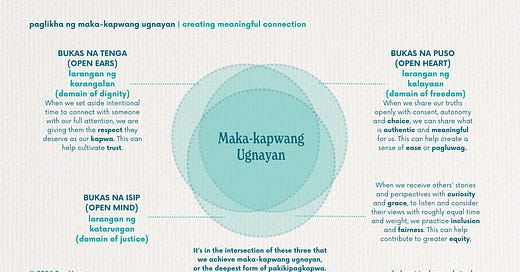Pagbubuo ng Maka-kapwang Ugnayan: A framework for meaningful connection
Sharing some notes as I make sense of "maka-kapwang ugnayan".
Hi, friends and subscribers. 😁
I kept putting off writing this post or about Designing for Connection because my thoughts and ideas were constantly evolving and emerging through my these recent experiences in the intersections of creativity, wellbeing, connection, culture, liberation and solidarity work.
A lot has happened since my last post here (I haven’t published in nearly two months): Winning the Good Design Award for Ugnayan Cards, responding to the impacts of Carina, deepening my work with Good Food Community through visits to political prisoners and understanding the struggle of women farmers, cultivating diverse communities, playing with different forms of creative expression, starting my expressive arts facilitation journey, etc. etc. etc.
I’m finally writing this now after recognizing my lull and after remembering that rough drafts of my ideas are okay to share here. 😊
If you’re a framework-y person, I share some notes here as I try to make sense of what meaningful connection looks like and how we might work towards it. Here goes!
Pagbubuo ng mga kaisipan |
Developing my thinking
In my dissertation, I started by doing a literature review and building the reasoning to come up with my framework on the motivations of sustainability leaders in the Philippines.1 Here, I began by trying to create a framework for creating connection first, and from there, tried to make the connection with what I believe make them work.
* If you’re not a reader, you can skip to the Kapwa and Solidarity section, and then backread if you’d like to understand the framework better. :)
But first, kapwa
I’ve written it about before but I’ll write it again here so we establish some definitions:
At the heart of meaningful connection or pakikipag-ugnayan is recognizing kapwa.2
Meaningful connection involves showing our true selves to others, while also showing genuine care for our kapwa.
Kapwa recognizes a shared identity or a shared inner self with others or our fellow beings. Kapwa is “a moral obligation to treat one another as equal fellow human beings”, says Virgilio Enriquez, father of Sikolohiyang Pilipino.
Kapwa is about returning to our humanity, and recognizing that we are more alike than different.
To add to this understanding of kapwa, I share a couple of frameworks to deepen understanding of the concept.
Pakikipagkapwa is defined as the ways we interact with our kapwa, and the work of Santiago and Enriquez outline different levels of kapwa as we move from seeing our kapwa as “other” to kapwa as “one of us”.
Furthermore, with the deeper expressions of pakikipagkapwa, there are also deeper accompanying values in those practices, as shared in the summary below.
Now that I’ve shared a bit more about the concept of kapwa, I’ll be sharing basic principles or practices that have guided me in creating brave, emergent spaces.
Bukas na tenga, puso at isip |
Open ears, heart and mind
In our gabay sa pakikipag-ugnayan (guide to connection) in our Ugnayan deck, we remind ourselves and those who use our deck to practice:
Bukas na tenga (open ears) - the practice of giving our attention
Bukas na puso (open heart) - the practice of sharing our authentic story
Bukas na isip (open mind) - the practice of listening to learn from others
This is the simplest way for me to express how we open up space for connection. It is not a groundbreaking guide. But sometimes, we forget to keep these in our minds, hearts and bodies when we interact with others.
I’ve been using these principles in facilitating spaces for Muni (back when we were more active), and in other workshops I’ve facilitated for various groups. Since my days with Muni, I’ve also looked at the ways different people have organized hubs or circles. I’ve found that these principles also aligned with the guidance on creating brave, emergent spaces from groups like The Work That Reconnects, All We Can Save circles, Good Grief Network facilitation training, Theory U, among others, and from facilitators I look up to, including adrienne maree brown, Prentis Hemphill, etc.
Kapwa and solidarity
While I’ve been using bukas na tenga, puso at isip for several years now, I’m thinking of it slightly differently today.
In the past year, I’ve had more exposure to Sikolohiyang Pilipino (SP) through casually (vs. intensely) reading some SP papers, conversations with my friend Kar Abola, posts by Carl Lorenz Cervantes, and more recently, my expressive arts facilitation course with The Arts And Health Institute.
I’ve also had more exposure to solidarity work with Good Food Community (e.g. with the urban poor and political prisoners).
These experiences haven gotten me to think more deeply about why bukas na tenga, puso at isip works, and how it can help us arrive at deeper and deeper expressions of pakikipagkapwa (towards hindi ibang tao).
It seems that kapwa’s deepest level of expression, pakikiisa is really about solidarity.
This has led me to assigning values to each of the practices for ugnayan:
Bukas na tenga (open ears) - Karangalan (dignity)
Bukas na puso (open heart) - Kalayaan (freedom)
Bukas na isip (open mind) - Katarungan (justice)
I make sense of each of these briefly in the image below.
And when I think about the values of the kapwa model once again:
At its deepest level, kapwa is about valuing dignity, justice and freedom, and this is reflected in the intentions and aspirations of maka-kapwang ugnayan.
Ultimately, maka-kapwang ugnayan is about recognizing our shared inner identity and shared humanity with others, and about giving our kapwa the dignity, justice and freedom we all deserve in our interactions with one another.
This is not to say I’m a perfect practitioner of this. There have been times when I’ve lost my patience, been disrespectful, made someone feel like they couldn’t fully express themselves with me, and when I think about that, I think mostly in the context of family. Sadly, it’s those closest to us (at least by blood and geography) who we sometimes (often) are challenged in connecting with.
I also know that I don’t necessarily have the emotional bandwidth to really really care about each person I come across or each story I encounter online, but I guess in aspiring for a culture of maka-kapwang ugnayan is the aspiration to:
widen our circles of care
expand the space for dignity, justice and freedom
deepen our practice of showing respect, curiosity and choice or autonomy
grow trust, equity and ease with our fellow beings
So that’s kind of where I’m at for now. The thoughts are still developing, and I’d love to know what’s resonating for you from here as well. 🙃
In true Jen fashion, I leave you with some questions for further reflection:
What does maka-kapwang ugnayan mean for you in your life?
With which individuals or circles do you get to practice this at its deepest level?
With which individuals or circles would you like to practice this more?
What do you need to feel greater trust, equity and ease in your relationships?
‘Til next time (hopefully not in two months),
Jen








